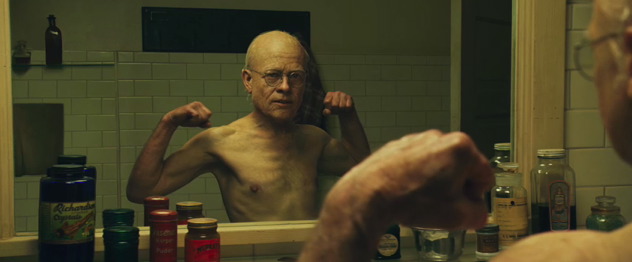40-year-old Ray Zahab talked about his recent record-breaking 33-day expedition to the South Pole. Along the way he stayed online and in touch with kids around the world along the way. His previous adventure was running 110 miles through the Sahara Desert. The punchline is that 5 years ago he was sedentary, smoking a pack a day.
 Score: 6 (out of 10) Balloons
Score: 6 (out of 10) BalloonsGolan Levin generates art from images and voices. Foofy.
 Score: 3 Balloons
Score: 3 BalloonsNina Jablonski delivered a good talk on the evolution of skin pigmentations. It's clear why pigmented skin protects equatorial populations, but I hadn't known why Eurasians evolved lighter skins during the three hominid migrations out of Africa (once Neanderthal, twice homo sapiens). Apparently less pigmented skin is better able to generate Vitamin D when needed, which preserves bone integrity and protects us from the kinds of radiation that penetrates at higher latitudes. So not only is it unhealthful for light skinned people to live in tropical climates, but there are also risks for dark skinned people who live far from the equator.
 Score: 7 Balloons
Score: 7 BalloonsArthur Benjamin is a math professor who performs mathemagics on the side. (Below is a prior demonstration at TED.) Instead of performing mental tricks this year, Art delivered an intriguing message about math education in the US:
Instead of building up to calculus as the epitome of math education, we should instead sequence our lessons so that every high school graduate understands statistics and probability. Calculus is nice for scientists to know, but statistics inform most complex decisions that people have to make both at work and at home. Undoubtedly, Benjamin is right that most people don't understand simple concepts like expected value, which perhaps explains the success of lotteries and casinos.
 Score: 8 Balloons
Score: 8 BalloonsHans Rosling came back to TED with his compelling data visualization techniques, using them to illustrate drivers of the AIDS epidemic in Africa. (Instead of a laser pointer he used a chair and pole.)
 Score: 8 Balloons
Score: 8 Balloons Margeret Wertheim is a writer of science history who, together with her sister, crocheted a coral reef. The reef became a surprise hit on the museum circuit, as 30 to 40 volunteer crocheters attracted through the web added to the now extensive reef. Many TEDsters seemed to think this was all cool for the sole reason that coral reefs are so important and yet endangered. Frankly I thought the whole thing was a silly waste of time until Margeret explained the relationship between coral reefs and crochet...
Margeret Wertheim is a writer of science history who, together with her sister, crocheted a coral reef. The reef became a surprise hit on the museum circuit, as 30 to 40 volunteer crocheters attracted through the web added to the now extensive reef. Many TEDsters seemed to think this was all cool for the sole reason that coral reefs are so important and yet endangered. Frankly I thought the whole thing was a silly waste of time until Margeret explained the relationship between coral reefs and crochet...In 1997 Dr. Daina Tamina at Cornell discovered that thanks to its undulating curved surfaces, crochet is the only straight-forward way to model hyperbolic structures. Hyperbolic surfaces exhibit non-Euclidean and even non-Lobochevskian geometries. Unlike Euclidean flat surfaces and Lobachevskian globes, on a hyperbolic surface there are infinity lines to be drawn through any given point that are parallel to an external line. You can see this on a crocheted fabric, where multiple contour lines can run through a single point.
 Score: 9 Balloons
Score: 9 BalloonsJennifer Mather gave a talk on octopus intelligence. She set forth parameters of intelligence and documented anecdotal evidence of octopus intelligence, such as "playing" with a floating object. Unfortunately she did so with no scientific rigor, explaining that somehow the experimental method doesn't work in this context. Once she convinced herself that octopi have personalities, she posed the profound question:
"Will they crawl out of the ocean and compete with us? No, that's physiologically impossible."
Oy, who has time for this?

Score: 1 Balloon
 Nalini Nadkarni loves and studies the forest canopy. She talked about epiphytes and other organisms that have adapted to this ecosystem. To staff one of her research projects involving the categorization of different mosses, she recruited prisoners, who have the time, the room, and the interest to study mosses (fortunately they didn't need any sharp tools to do the work). Now she's using them to raise the endangered Oregon Spotted Frog, "in captivity" of course. To promote the field, Nalini's team collected hundreds of old Barbie dolls and converted them into Treetop Barbie, to get girls excited about the field. Lots of TED points here for inter-disciplinary collaboration.
Nalini Nadkarni loves and studies the forest canopy. She talked about epiphytes and other organisms that have adapted to this ecosystem. To staff one of her research projects involving the categorization of different mosses, she recruited prisoners, who have the time, the room, and the interest to study mosses (fortunately they didn't need any sharp tools to do the work). Now she's using them to raise the endangered Oregon Spotted Frog, "in captivity" of course. To promote the field, Nalini's team collected hundreds of old Barbie dolls and converted them into Treetop Barbie, to get girls excited about the field. Lots of TED points here for inter-disciplinary collaboration. Score: 7 Balloons
Score: 7 BalloonsFriday's highlight was certainly Bonnie Brassler from Princeton. She and her grad students have discovered that bacteria communicate extensively, and she explained how and why they do it. She began her talk by pointing out that 90% of the cells in a human being -- and 99% of the genes -- are bacterial, so we ought to pay attention to the critters.
 Four years ago Hawaiian researchers discovered a squid in shallow waters that uses luminescent bacteria to counteract its shadow in order to hide itself from predators. It has two lobes full of luminescent bacteria that glow only at night when it's awake and hunting, and just enough of the lobes are exposed downward to offset the right amount of moonlight and starlight of the particular evening. What an amazing adaptation.
Four years ago Hawaiian researchers discovered a squid in shallow waters that uses luminescent bacteria to counteract its shadow in order to hide itself from predators. It has two lobes full of luminescent bacteria that glow only at night when it's awake and hunting, and just enough of the lobes are exposed downward to offset the right amount of moonlight and starlight of the particular evening. What an amazing adaptation.But a curious property of the squid caught Bassler's attention. The squid can essentially turn the light on and off (no dimming), so the lobes glow only at night. What makes the bacteria all start and stop glowing at once?
Bassler's team discovered a mechanism in the bacteria -- and subsequently in all bacteria -- that allows them to communicate. Specifically, each bacteria emits a stream of enzymes for which it also has a receptor. The receptor acts like a switch in the bacteria, so that when the enzyme reaches a certain density in the solution around the bacteria, something inside the bacteria responds, perhaps by starting to glow. Therefore the bacteria doesn't start to glow until there is a sufficient concentration of bacteria around it. And when it starts to glow, it also accelerates its enzyme emission so that all the bacteria in the colony get the signal at roughly the same time. The squid flushes 95% of the bacteria each morning, which turns off the light, and during the day the colony grows until it reaches critical mass at night.
This mechanism explains how bacterial infections are able to overcome our immune defenses. They enter our bodies in a slow-growing relatively harmless state, and only after amassing a sizable cluster of agents do they suddenly, simultaneously attack.
Bassler also discovered an inter-species communication systems, so that bacteria know when there are other bacteria around outside their species. Essentially there is a universal enzyme that they all emit and receive, so that they can behave differently depending upon the presence of other strains.
With this awareness of bacterial communication networks, Bassler's team is pursuing a novel approach to fighting infection. Instead of trying to kill the cells one at a time, which often leads to resistance, we can develop molecules that bind to the communication enzyme, immediately shutting down the attack. It's like turning off the light in the squid.
Beautiful!
 Score: 10 Balloons
Score: 10 Balloons I awoke early on Thursday to ensure I wouldn't miss the first speaker,
I awoke early on Thursday to ensure I wouldn't miss the first speaker, 



 I normally don't expect to like the design-oriented talks, but
I normally don't expect to like the design-oriented talks, but 








 Jonathan Drori told the story of his
Jonathan Drori told the story of his 
